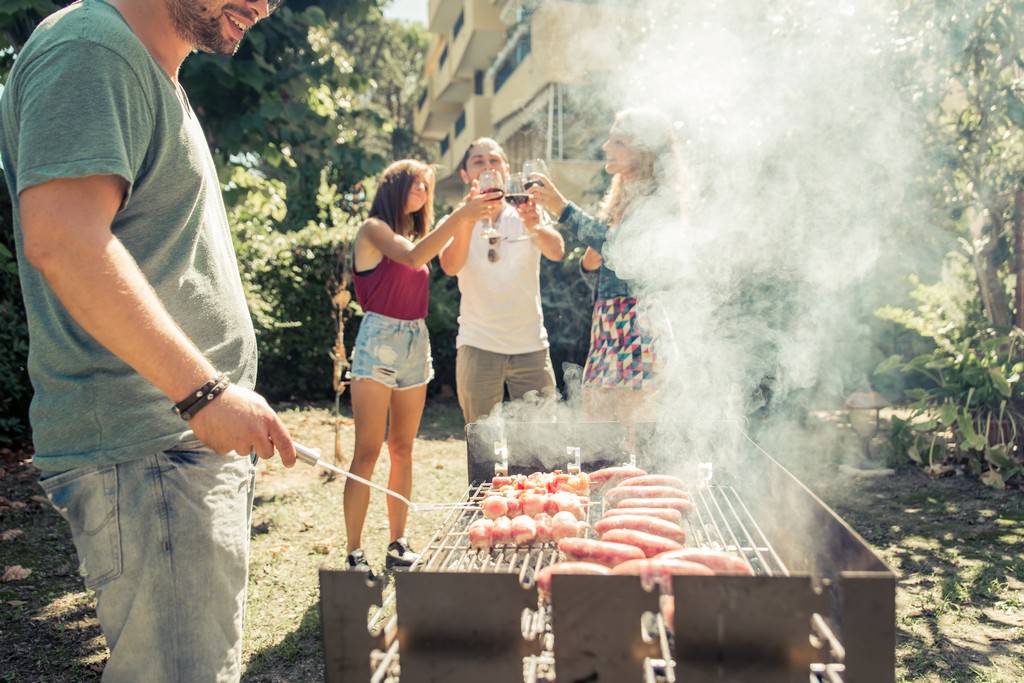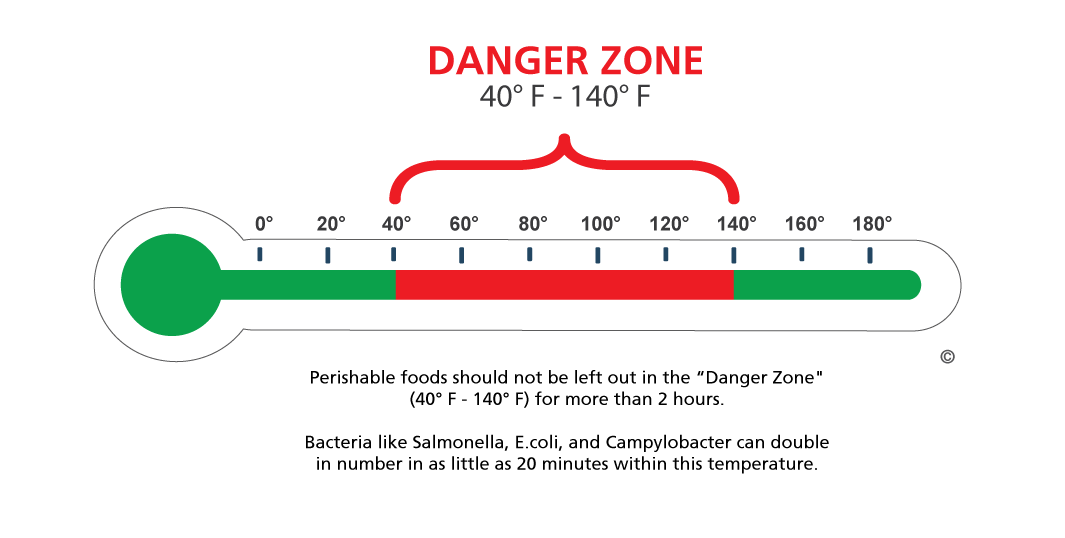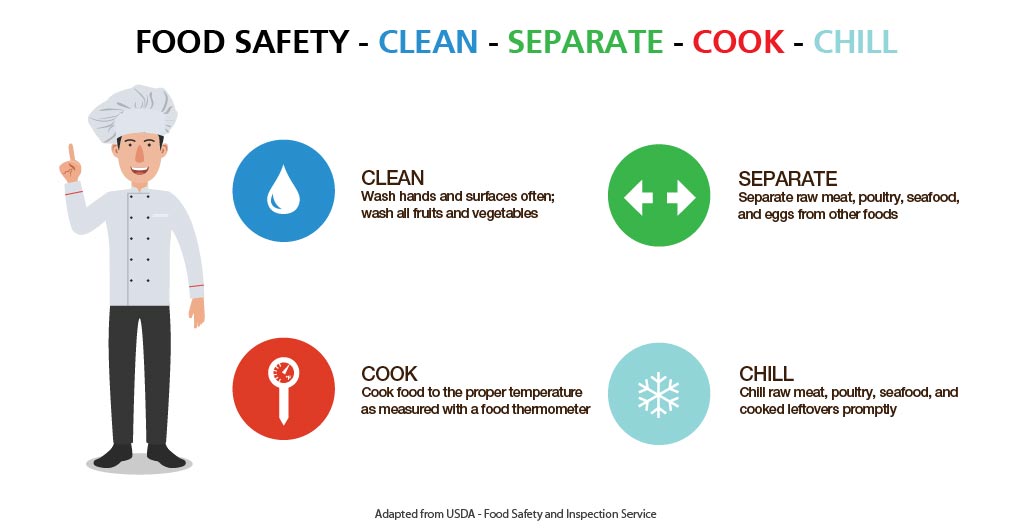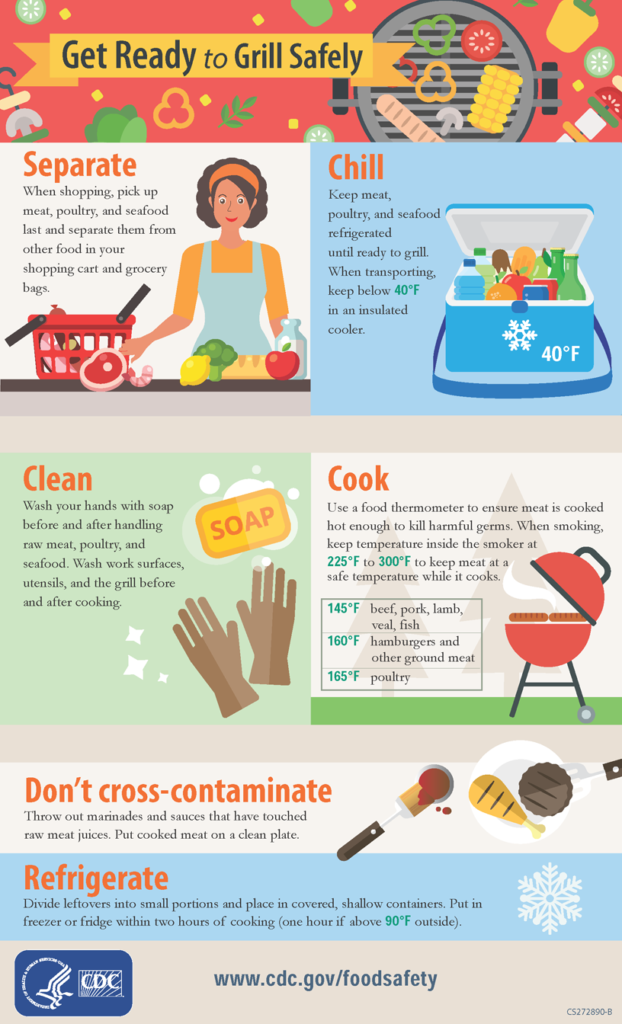July is National Grilling Month! As temperatures get hotter, there’s nothing like outdoor grilling and soaking up the sunshine! However, food poisoning peaks in the summer months when warmer temperatures cause foodborne germs to flourish.
To protect yourself, your family, and friends from foodborne illness during warm-weather months, safe food handling when eating outdoors is critical.
 Image Source: Shutterstock
Image Source: Shutterstock Temperature Danger Zone
Eating outdoors in warm weather presents a food safety challenge. Bacteria in food multiply faster at temperatures between 40°F and 140°F, so summer heat makes the basics of food safety especially important.

Food Safety Steps: Separate – Chill – Clean – Cook

Clean
Hands. Wash your hands with soap before and after handling raw meat, poultry, and seafood. Wash work surfaces, utensils, and the grill before and after cooking.
Grill and tools. Use a moist cloth or paper towel to clean the grill surface before cooking. If you use a wire bristle brush, thoroughly inspect the grill’s surface before cooking. Wire bristles from grill cleaning brushes may dislodge and stick into food on the grill.
Separate
When shopping, pick up meat, poultry, and seafood last, right before checkout. Separate them from other food in your shopping cart and grocery bags. To guard against cross-contamination, put packages of raw meat and poultry into individual plastic bags.
- Learn about foodborne pathogens, cross contamination, cold and hot food safety, and best practices to prevent foodborne illness.
- Food Manager ANSI Certification: $99.00 - Valid in all States
- Food Handler Training: Only $7.00!
- 10% OFF: Enter Promo Code "train10off" at Checkout
Cook
Use a food thermometer to ensure meat is cooked hot enough to kill harmful germs. When smoking, keep temperatures inside the smoker at 225°F to 300°F to keep meat a safe temperature while it cooks.
| Food | Type | Internal Temperature (°F) |
|---|---|---|
| Ground meat and meat mixtures | Beef, pork, veal, lamb | 160 |
| Turkey, chicken | 165 | |
| Fresh beef, veal, lamb | Steaks, roasts, chops Rest time: 3 minutes |
145 |
| Poultry | All Poultry (breasts, whole bird, legs, thighs, wings, ground poultry, giblets, and stuffing) | 165 |
| Pork and ham | Fresh pork, including fresh ham Rest time: 3 minutes |
145 |
| Precooked ham (to reheat) Note: Reheat cooked hams packaged in USDA-inspected plants to 140°F |
165 | |
| Eggs and egg dishes | Eggs | Cook until yolk and white are firm |
| Egg dishes (such as frittata, quiche) | 160 | |
| Leftovers and casseroles | Leftovers and casseroles | 165 |
| Seafood | Fish with fins | 145 or cook until flesh is opaque and separates easily with a fork |
| Shrimp, lobster, crab, and scallops | Cook until flesh is pearly or white, and opaque | |
| Clams, oysters, mussels | Cook until shells open during cooking |
Chill
Divide leftovers into small portions and place in covered, shallow containers. Put in freezer or fridge within two hours of cooking (one hour if above 90°F outside).
Grill Safely
Whether you’re a weekend-only griller, or you fire up the grill on a daily basis, keep your summer food safe with important principles and procedures.

National Fire Protection Association Grilling Safety Tips
This grilling season, the NFPA demonstrates the proper way to use your grill safely to prevent fires.
Additional Grilling Food Safety Resources
- Barbecue and Food Safety
- Is It Done Yet?
- FoodSafety.gov – BBQ+A: Answers to Your Most Common Barbeque Questions
- FoodKeeper App
- FoodSafety.gov – Grilling Food Safety 101
- CDC – BBQ IQ — Get Smart. Grill Safely.
- CDC Grilling Food Safety Infographic (PDF)
